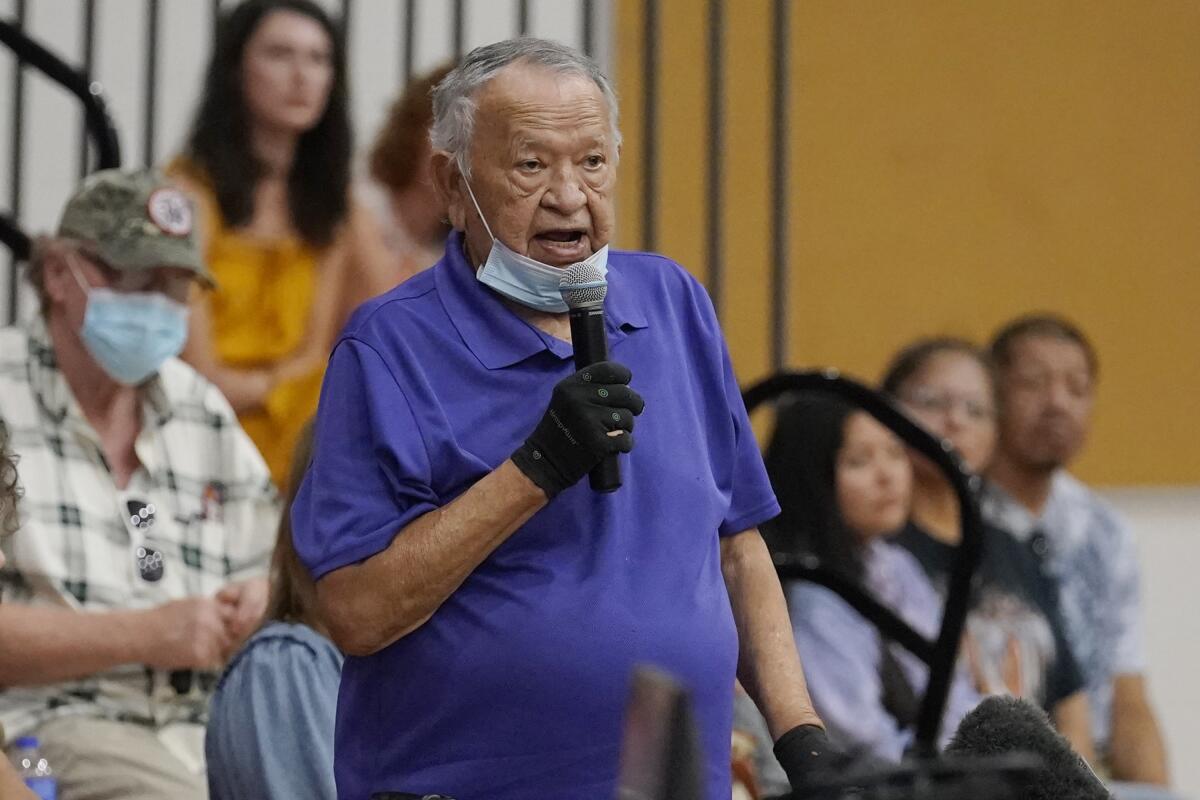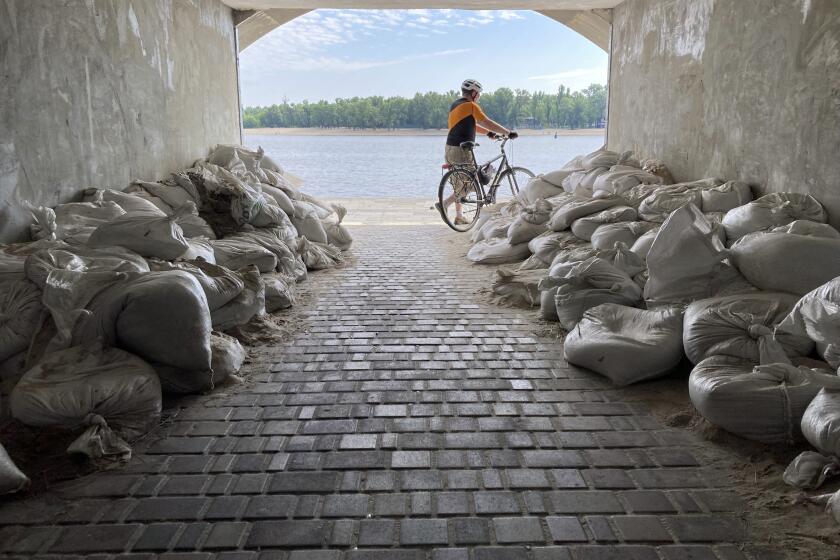Tribal elders recall painful boarding school memories

- Share via
ANADARKO, Okla. — Native American tribal elders who were once students at government-backed Indian boarding schools testified Saturday about the hardships they endured, including beatings, whippings, sexual assaults, forced haircuts and painful nicknames.
They came from different states and different tribes, but they shared the common experience of having attended the schools that were designed to strip Indigenous people of their cultural identities.
“I still feel that pain,” said 84-year-old Donald Neconie, a former U.S. Marine and member of the Kiowa tribe who once attended the Riverside Indian School in Anadarko, about 80 miles southwest of Oklahoma City. “I will never, ever forgive this school for what they did to me.
“It may be good now. But it wasn’t back then.”
As the elders spoke, U.S. Secretary of the Interior Deb Haaland, herself a Laguna Pueblo from New Mexico and the first Native American Cabinet secretary in U.S. history, listened quietly. The event at the Riverside Indian School, which still operates today but with a vastly different mission, was the first stop on a yearlong nationwide tour to hear about the painful experiences of Native Americans who were sent to the government-backed boarding schools.
“Federal Indian boarding school policies have touched every Indigenous person I know,” Haaland said at the start of the event, which attracted Native Americans from throughout the region. “Some are survivors. Some are descendants. But we all carry the trauma in our hearts.
“My ancestors endured the horrors of the Indian boarding school assimilation policies carried out by the same department that I now lead. This is the first time in history that a Cabinet secretary comes to the table with this shared trauma.”
At least 15 people were killed when a Russian rocket hit an apartment building in the eastern Ukraine town of Chasiv Yar, officials said.
Haaland’s agency recently released a report that identified more than 400 of the schools, which sought to assimilate Native children into white society during a period that stretched from the late 18th century until the late 1960s.
Although most closed their doors long ago and none still exist to strip students of their identities, some still function as schools, albeit with drastically different missions that celebrate the cultural backgrounds of their Native students. Among them is Riverside, which is one of the oldest.
Riverside, which opened in 1871, serves students from grades four through 12 these days, offering them specialized academic programs as well as courses on cultural topics such as bead-working, shawl-making and an introduction to tribal art, foods and games. Currently operated by the Bureau of Indian Education, it has nearly 800 students from more than 75 tribes across the country, and the school’s administration, staff and faculty are mostly Native American.
It is one of 183 elementary and secondary schools across the country funded by the Bureau of Indian Education that seek to provide education aligned with a tribe’s needs for cultural and economic well-being, according to the bureau’s website.
But Riverside also has a dark history of mistreating the thousands of Native American students who were forced from their homes to attend it.
Neconie, who still lives in Anadarko, recalled being beaten if he cried or spoke his native Kiowa language when he attended Riverside in the late 1940s and early 1950s.
“Every time I tried to talk Kiowa, they put lye in my mouth,” he said. “It was 12 years of hell.”
Brought Plenty, a Standing Rock Sioux who lives in Dallas, recalled the years she spent at Indian boarding schools in South Dakota, where she was forced to cut her hair and told not to speak her Native language. She recalled being forced to whip other girls with wet towels and being punished when she didn’t.
“What they did to us makes you feel so inferior,” she said. “You never get past this. You never forget it.”
Until recently, the federal government hadn’t been open to examining its role in the troubled history of Native American boarding schools. But this has changed because people who know about the trauma that was inflicted hold prominent positions in government.
At least 500 children died at such schools, but that number is expected to reach into the thousands or tens of thousands as more research is done.
The Interior Department’s report includes a list of the boarding schools in what were states or territories that operated between 1819 and 1969 that had a housing component and received support from the federal government.
Oklahoma had the most, 76, followed by Arizona, which had 47, and New Mexico, which had 43. All three states still have significant Native American populations.
Former students might be hesitant to recount the painful past and trust a government with policies that were to eradicate tribes and, later, assimilate them under the veil of education. But some welcome the opportunity to share their stories for the first time.
Not all the memories from those who attended the schools were painful ones.
Dorothy WhiteHorse, 89, a Kiowa who attended Riverside in the 1940s, said she recalled learning to dance the jitterbug in the school’s gymnasium and learning to speak English for the first time. She also recalled older Kiowa women who served as house mothers in the dormitories who let her speak her Native language and treated her with kindness.
“I was helped,” WhiteHorse said. “I’m one of the happy ones.”
But WhiteHorse also had some troubling memories, including the time she said three young boys ran away from the home and got caught in a snowstorm. She said all three froze to death.
“I think we need a memorial for those boys,” she said.
More to Read
Sign up for Essential California
The most important California stories and recommendations in your inbox every morning.
You may occasionally receive promotional content from the Los Angeles Times.











